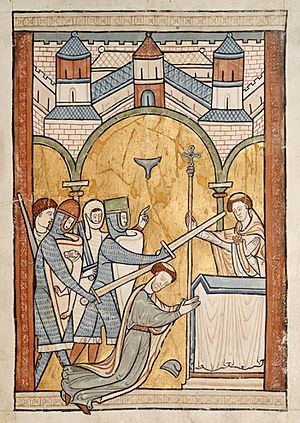Hugh de Morville, Lord of Westmorland facts for kids

Sir Hugh de Morville (who died around 1173) was an Anglo-Norman knight. He worked for King Henry II of England in the late 1100s. He is most known for being one of the knights who killed Thomas Becket. Becket was the Archbishop of Canterbury in 1170. Hugh de Morville was also known as the Lord of Westmorland and Knaresborough.
Contents
A Knight in Westmorland
Hugh de Morville was likely the oldest son of his father, who was also named Hugh de Morville. He started serving King Henry II around 1158. Historians believe he gave out two important documents as the Lord of Westmorland. One of these was read aloud at his castle in Appleby. This castle was located near the River Eden.
Some people who witnessed these documents were important figures. One was Harvard de Malnurs, who was the Constable of Knaresborough Castle. Another was Reginald de Beauchamp, who might have been related to Hugh's mother. These connections show how important Hugh de Morville was in his region.
The Murder of Thomas Becket
Hugh de Morville and three other knights of King Henry II were involved in a terrible event. These knights were Reginald Fitzurse, William de Tracy, and Richard le Breton. They believed the king wanted Thomas Becket dead. The king had supposedly said, "What miserable drones and traitors have I nourished and brought up in my household, who let their lord be treated with such shameful contempt by a low-born cleric?"
The knights took these words as a command. They then killed Archbishop Becket inside Canterbury Cathedral. This happened on December 29, 1170. After the murder, King Henry told the knights to escape to Scotland. They found safety at de Morville's Knaresborough Castle.
Punishment and Exile
Hugh de Morville, Richard de Brito, and William de Tracy later built a church. It was in Alkborough, near Scunthorpe. This was an attempt to show they were sorry. However, Pope Alexander III was not impressed. He officially removed Tracy and the other murderers from the Church. This happened on March 25, 1171.
Tracy left for Rome to seek forgiveness. But Hugh de Morville and the other knights had to wait. They first took part in a rebellion against the king in 1173–74. After this, they finally met the Pope. The Pope saw their regret. Still, he ordered them to be exiled. They had to fight as knights for 14 years in Jerusalem with the Knights Templar. After this time, they were told to return to Rome.
The End of the Knights
Historians believe that Sir William de Tracy did travel east as ordered. Reports say the Pope told the knights to visit holy places. They were to do this barefoot and wearing rough clothes. Then, they were to live alone for the rest of their lives. This was to happen on the Black Mountain near Antioch. They were to spend their time praying and showing sorrow.
Some traditions say the knights were buried in Jerusalem. Their bodies were placed near the door of the temple. Another story says they were buried under a porch in front of the Al-Aqsa Mosque. This mosque was once a dining hall for the Knights Templar. There is also a tradition that their bodies were returned to Brean Down island in England and buried there.
The land of Westmorland later went to Hugh's sister, Maud, in 1174. She held the lands until Hugh's punishment was completed.

